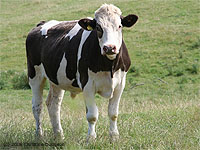Why An IBR Vaccine Should Be Used
18 January 2017Marker vaccines have been an exciting development in the control of IBR. To understand their use some principles need to be understood.
- The marker vaccine contains the organism that causes the disease, but it has had a part removed. In the case of IBR virus this was a spontaneous mutation and the missing part is glycoprotein E, which is part of the external shell of the virus.
- When animals are infected with the IBR virus they respond by producing antibody against the proteins in the external shell of the virus.
- When they are vaccinated with the marker vaccine they also produce antibody against the outer shell, but as the shell of the marker vaccine does not contain the glycoprotein E no antibody is produced against this part of the virus.
- We test for the presence of antibody in the blood or milk of an animal using a test called the ELISA. This can be constructed to detect antibody against one part of the shell of the virus. The standard test is focused on the glycoprotein B.
- Animals that have been infected or vaccinated will produce antibody against glycoprotein B and test positive in the standard test.
- We have a marker vaccine ELISA. This is called the gE ELISA and detects antibody against glycoprotein E. Therefore if an animal has been infected with IBR virus it will test positive in this test. If it has only been vaccinated with the marker vaccine it will test negative as it has no antibody to glycoprotein E. (Calling the test “the marker vaccine test” does cause confusion as it does not in fact detect marker vaccination, but it is used in marker vaccinated animals.)
- Finally the virus in the conventional IBR vaccine has the glycoprotein E present and the antibody response in animals vaccinated with the conventional vaccine is indistinguishable from that seen in the infected animal. It will test positive in the gB and in the gE ELISA.
To harness marker vaccine for best effect all herds selling breeding stock that have IBR present are best advised to use the marker vaccine. This allows the gE ELISA to be used to show up whether marker vaccinated animals have also been infected. Note that for those herds hoping to sell to AI stud or to export then the animals destined for these purposes should not be vaccinated, but the rest of the herd should be.
Some countries, notably Ireland, have removed conventional IBR vaccines and only marker vaccine is available. This would be an early measure to take if the country wished to move to IBR eradication in the future.
George Caldow, george.caldow@sac.co.uk
Sign up to the FAS newsletter
Receive updates on news, events and publications from Scotland’s Farm Advisory Service

